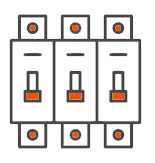MCB FAQs

MCB FAQs
POINTS TO REMEMBER
Number of Circuits
To create a dependable and safe electrical system, the number of circuits that can efficiently handle the load without producing overload must be carefully considered. Installing individual Miniature Circuit Breakers (MCBs) for high-power-consuming equipment is advised to contain power surges or short circuits within specific circuits, minimising the risk of damage to the overall system. The ideal number of courses must be determined after thoroughly reviewing projected load patterns, power requirements, and the number of electrical outlets. To achieve energy efficiency and safety, factors like facility design, occupancy, and equipment usage should be considered. Longevity and reliability can be considerably increased by constructing an electrical system with the proper number of circuits and safety precautions.
Current Carrying Capacity
The maximum amount of electrical current that a conductor can securely carry without suffering damage or overheating is determined by its current carrying capacity, also known as ampacity. The size, insulation, ambient temperature, conductor material, and current type (AC or DC) are a few of the variables that affect transport capacity. Greater current can be carried by larger conductors than by smaller ones, and copper conductors can carry more current than aluminium conductors can because copper has a lower resistance than aluminium. As the temperature rises, the conductor’s resistance rises, which can cause overheating and failure. As a result, the ambient temperature is also an important factor. Therefore, it is essential to take into account the conductor’s insulation temperature rating and the environment’s maximum working temperature when calculating its current carrying capability. To avoid risks like overheating, melting, or electrical fires, conductors must be properly chosen and able to bear the anticipated electrical load. Safety and compliance are ensured by the application of electrical codes and the consultation of experienced experts during the design phase.
Quality of Material
It is impossible to emphasise the importance of high-quality materials in electrical circuits. An electrical system’s dependability and safety heavily on the components it uses, and any use of defective materials might have fatal consequences. Using only the best materials is essential, whether in residential, commercial, or industrial settings. Among these components, wires are essential because they transport electrical load and act as conduits. Poor wires pose serious threats to life and property since they can cause overheating, melting, and even fires. High-quality wires, on the other hand, are made to handle the electrical load and heat produced by the circuit, providing optimum performance and safety. They are made from top-notch materials and uphold high-quality standards, which lessen the possibility of overheating or fires. The MCB box, which guards against overcurrent and short circuits in the electrical system, should also be of the highest calibre. Poor-quality MCB boxes may fail to trip in urgent circumstances, endangering the system and posing serious dangers. To ensure compliance with safety standards and regulations, it is necessary to use caution when choosing materials for electrical circuits, particularly for the MCB box and Electrical Panel, and to seek the advice of trained electrical engineers or technicians. Electrical circuits must utilise high-quality materials to provide optimal performance and safety because using inferior materials can jeopardise the integrity of the entire system.
Fool Proof Safety
It is crucial to take comprehensive and reliable safety precautions in any area that has electricity. Electrical systems now require specific safety components, including distribution boards, 2-way changeover switches, moulded case circuit breakers, residual current circuit breakers, and miniature circuit breakers. RCCBs and MCCBs are essential for electrical safety because they serve as early detection devices for current leakage and safeguard people from the risk of electric shock by immediately switching off the power in the case of an imbalance. By cutting off the faulty circuit, MCBs, on the other hand, protect against electrical system overload and short circuits, limiting possible hazards and damage. Integrating both RCCBs and MCBs is critical for a comprehensive and reliable electrical safety approach. This ensures the identification and management of numerous electrical defects that could otherwise be dangerous to human safety, cause severe property damage, or even result in death. The use of RCCBs and MCBs in electrical systems is critical for maximum safety and protection.
Frequently Tripping MCB
An MCB (Miniature Circuit Breaker) is a device that protects electrical circuits against overcurrent, short circuits, and other defects. However, there are a number of variables that can lead an MCB to trip on a regular basis. Overloading, or connecting too many devices to a single circuit, can overload the MCB and cause it to trip. Damaged wires, loose connections, or defective appliances generate short circuits, resulting in an excessive current flow that trips the MCB. Ground leakage, which occurs when current flows to the ground rather than the neutral line due to insufficient equipment or broken insulation, can also cause the MCB to trip. Furthermore, a malfunctioning MCB may trip even in the absence of a circuit failure. To determine the underlying cause of frequent MCB tripping, it is advisable to consult a certified electrician who can conduct a thorough inspection of the electrical circuit and identify the specific issue.
Wire Connections
Securing wire connections with lugs or thimbles is critical for preventing risks and ensuring the electrical system’s safety and efficiency. Loose connections can result in hazardous results, such as faulty equipment or fires caused by sparking. Wires can be securely linked throughout the installation process by employing lugs and thimbles, reducing the risk of sparking and improving overall safety. These small tools offer dependable connections that can withstand stress and tension, ensuring the security of wire connections even in difficult settings. Finally, the employment of lugs and thimbles helps to create a more trustworthy, safe, and efficient electrical system.
MCB Category to Use
Modern electrical systems must have MCBs because they guard against overloads and short circuits. The kind of electrical load that an MCB can safely carry is determined by its rating, which is unique to each category of MCB. The exact electrical load that a circuit needs to protect dictates which MCB category should be used. Electric ovens, geysers, and water heaters are examples of resistive loads that produce heat. Therefore, category “B” MCBs are the best choice for circuits containing these types of loads. On the other side, category ‘C’ MCBs are made for inductive loads, which include magnetically field-producing appliances like refrigerators, air conditioners, and electric motors. Inadequate performance, early failure, or safety issues might come from selecting the incorrect category of MCB for a circuit. For instance, utilising a ‘C’ category MCB for a heating load may result in failure in tripping, causing overheating and potential fire dangers, whereas using a ‘B’ category MCB for an inductive load may induce superfluous tripping due to high inrush current. In light of the particular electrical load the circuit must safeguard, it is crucial to choose the proper MCB category.
Protecting Electrical Installations
Electrical installations need to be set with great care, following industry best practices, to ensure their integrity and safety. Keeping these installations safe from environmental hazards like dust and rain is an important consideration. Equipment breakdown, short circuits, electrocution, and fires are just a few potential hazards that could result from failing to comply with these requirements. The importance of investing in high-quality safeguards like Moulded Case Circuit Breakers, seals, and enclosures cannot be overstated when it comes to protecting electrical systems like Electrical Control Panels and Distribution Boards. Components can be further shielded from moisture and contaminants by using extra safety measures, including MCB boxes, RCCBs, and 2-way changeover switches. For maximum safety, electrical components, including MCBs and Distribution Boards, must be properly grounded, insulated, and maintained on a regular basis. Individuals and organisations can ensure the dependable and secure operation of their electrical systems for an extended period of time by giving priority to the protection of electrical installations from precipitation and dust.
Earthing Electrical Equipments
Electrical safety depends heavily on the proper grounding of electrical devices. By grounding electrical equipment, you can safely channel fault currents away from your equipment and avoid electrical shocks, fires, and other potentially dangerous circumstances. Inadequate grounding can result in electrical discharge, which puts people in danger of electrocution, short circuits, and electric shocks. Thus, it is essential to follow electrical safety standards and laws when grounding electrical equipment, and the task should be carried out by qualified, experienced, and licensed specialists who possess the required education and training. It is impossible to stress the importance of grounding as a fundamental safety measure to reduce electrical dangers and guarantee the safety of people and property.
MCB SELECTION CRITERIA
When choosing a Miniature Circuit Breaker (MCB), several factors should be considered, including rating, breaking capacity, trip characteristics, number of poles, installation style, and brand/quality. The maximum current rating of the circuit and the breaking capacity of the MCB should be the same. Additionally, the breaking capacity should be greater than the maximum fault current that may occur. The number of phases in the circuit should be considered when determining the MCB’s number of poles. The MCB should be selected based on how well it can endure the installation environment.
| APPLIANCES | CAPACITY/ WATT ( LOAD) AT 240~ SINGLE PHASE | MCB RATING | ||||
| Air Conditioner | 1.0 Ton | 10A | ||||
| 1.5 Ton | 16A | |||||
| 2.0 Ton | 20A | |||||
| Cooking Range | With oven cum griller 4500 Watts | 25A | ||||
| With oven cum griller 1750 Watts | 10A | |||||
| Oven only 750 Watts | 6A | |||||
| Hot Plate only 2000 Watts | 10A | |||||
| Room Heater | 1000 Watts | 6A | ||||
| 2000 Watts | 6A | |||||
| Geyser (Storage instantenous) | 1000 Watts | 10A | ||||
| 2000 Watts | 10A | |||||
| 3000 Watts | 16A | |||||
| 6000 Watts | 32A | |||||
| Washing Machine(Automatic) | 1300 Watts | 6A | ||||
| LCD & LED TV | 750 Watts | 6A | ||||
| Photo Copier | 1500 Watts | 6A | ||||
| Electric Kettle | 1500 Watts | 10A | ||||
| Mixer Grinder | 1000 Watts | 6A | ||||
| Toaster | 1200 Watts | 6A | ||||
| Electric Iron | 1250 Watts | 6A | ||||













